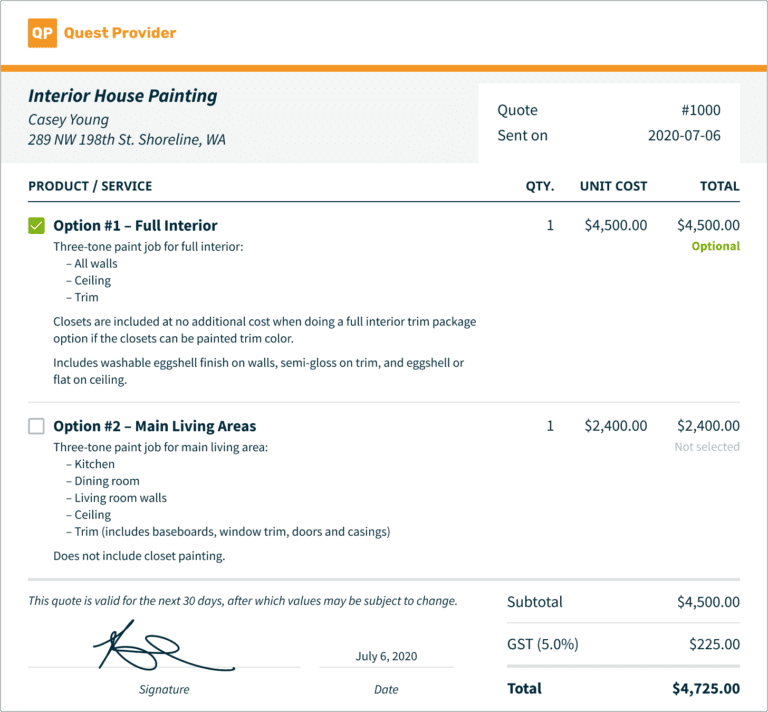Is an Estimate a Contract? 6 Things to Know About Protecting Your Business
Stop us if you’ve heard this one—you estimate a job, the client approves the estimate, you do the work, and you send your invoice. But the client says your invoice is too high, they stall on payment, or they flat-out refuse to pay.
The best way to avoid this situation is to create a binding estimate for every job. When it’s done right, a binding estimate can form a contract for your working relationship with the client.
In this article, we’ll go through what a binding estimate is and how to make one. This will give you the tools you need to impress your clients, protect your business, and get paid on time, every time.
Get answers to your questions about binding estimates:
⚠️ Disclaimer: This content is for informational purposes only and should not be considered legal, accounting, or tax advice, or a substitute for obtaining such advice specific to your business. Please refer to an experienced lawyer in your jurisdiction for particular information on how to write legally binding terms and conditions.
What’s the difference between an estimate vs contract?
An estimate is an educated guess for how much a job will cost to complete. You can give it to clients verbally or in print, and the client can approve it, reject it, or negotiate terms.
A contract is a legal document that both you and your client sign. It dictates the terms of your working relationship so your client receives quality services, and you get fairly compensated.
While the estimate is just an offer to provide work, a contract is a binding agreement around that work—and it’ll hold up in court. So if either party tries to back out, the other is protected.
READ MORE: Quote, estimate, bid, and proposal: how are they different?
What is a binding estimate?
A binding estimate means the price you estimated is the price the client will pay. So if you estimate $2,000 worth of work but have to do $1,500 or $3,000, you’ll get $2,000 either way.
Just for comparison, a non-binding estimate is your best guess at what a job will cost, with the client understanding that this amount could be higher or lower by the end of the project.
Finally, a binding not-to-exceed estimate ensures the client will definitely pay no more than the estimated amount—but could also pay less.
READ MORE: Cost estimate vs budget: how they affect your pricing and bottom line
Here’s how binding estimates can help you and your business:
• Set expectations early with clients
• Plan and predict cash flow
• Impress clients and encourage them to purchase services
• Order the right supplies and material quantities
• Have proof of an agreement if there’s a dispute
• Clients with a binding estimate are also more likely to pay on time and in full.
Is an estimate legally binding?
Normally a job estimate isn’t legally binding. However, it can form a binding agreement when it’s in writing and it includes:
✅ Who the agreement is between (you and your client)
✅ A detailed explanation of how you and your client benefit from the agreement (e.g., a kitchen redesign for $25,000)
✅ A list of services you’ll be providing (what’s included and not included)
✅ A statement of the maximum amount the client will pay when the job’s done
✅ Any estimate disclaimers, terms, or conditions, including factors that could affect service quality or delivery
✅ The client’s signature or email confirmation showing they accept the terms of the estimate
READ MORE: Free estimates: should contractors charge for quotes?
Is signing an estimate a contract?
It can be, if your estimate is detailed enough and it has the client’s signature. Like any contract, you’ll need to send a copy of the signed estimate to the client for their records.
Your estimate should include language saying the estimate will become a contract when the client signs it. This also tells your client that signing the document will kick off the project.
Either you or your client can cancel the agreement before the project’s finished. Depending on the language in your estimate, the client may not have to pay anything more than a non-refundable deposit.
READ MORE: How to politely ask clients for an upfront deposit (with examples)
Is an estimate binding when it’s verbal?
A verbal estimate can be binding, but only if you can prove it exists and the client approved it. A handshake agreement or off-the-cuff guesstimate doesn’t provide that proof.
That’s why it’s a good idea to create a binding estimate using estimating software. It’ll document what’s included in your estimate and whether the client has approved it.
This will allow you to deal with any client objections and stick to your fixed price.
How to make a legally binding estimate
Make your legally binding estimate using an estimate template. It should include what services you’re providing, what they’ll cost, and under what terms you’ll be working.
When you’re making a legally binding estimate, make sure to:
- Put the estimate in writing
- Make your price as accurate as possible
- Get the client’s signed approval of the estimate
Here’s what a binding estimate could look like:

READ MORE: Price bundling: when, why, and how to offer stellar service packages
Don’t worry—you can still talk through the job with the client, come to terms, and shake on it. Just make sure you send a binding estimate afterwards and don’t start work until you get a signed copy of the estimate.